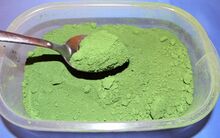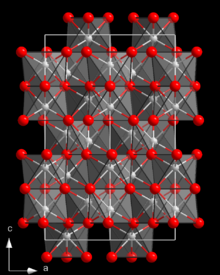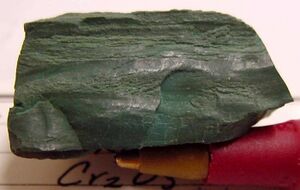أكسيد الكروم الثلاثي

| |

| |
| الأسماء | |
|---|---|
| أسماء أخرى | |
| Identifiers | |
| رقم CAS | |
3D model (JSmol)
|
|
| ChEBI | |
| ChemSpider | |
| ECHA InfoCard | 100.013.783 |
| رقم EC |
|
| مرجع Gmelin | 11116 |
PubChem CID
|
|
| رقم RTECS |
|
| UNII | |
| UN number | 3077 |
CompTox Dashboard (EPA)
|
|
| InChI | InChI={{{value}}} |
| SMILES | |
| الخصائص | |
| الصيغة الجزيئية | Cr2O3 |
| كتلة مولية | 151.9904 g/mol |
| المظهر | light to dark green, fine crystals |
| الكثافة | 5.22 g/cm3 |
| نقطة الانصهار | |
| نقطة الغليان | |
| قابلية الذوبان في الماء | insoluble |
| قابلية الذوبان في alcohol | insoluble in alcohol, acetone, acids |
| القابلية المغناطيسية | +1960.0×10−6 cm3/mol |
| معامل الانكسار (nD) | 2.551 |
| البنية | |
| البنية البلورية | Corundum |
| الزمرة الفراغية | R3c (No. 167) |
| ثابت العقد | a = 495 pm, c = 1358 pm |
| الكيمياء الحرارية | |
| الإنتالپية المعيارية للتشكل ΔfH |
−1128 kJ·mol−1 |
| Standard molar entropy S |
81 J·mol−1·K−1 |
| المخاطر | |
| ن.م.ع. مخطط تصويري |  
|
| ن.م.ع. كلمة الاشارة | Danger |
| H302, H317, H319, H360 | |
| P201, P202, P261, P264, P270, P272, P280, P281, P301+P312, P302+P352, P305+P351+P338, P308+P313, P321, P330, P333+P313, P337+P313, P363, P405, P501 | |
| حدود التعرض الصحية بالولايات المتحدة (NIOSH): | |
PEL (المسموح)
|
TWA 1 mg/m3[1] |
REL (الموصى به)
|
TWA 0.5 mg/m3[1] |
IDLH (خطر عاجل)
|
250 mg/m3[1] |
ما لم يُذكر غير ذلك، البيانات المعطاة للمواد في حالاتهم العيارية (عند 25 °س [77 °ف]، 100 kPa). | |
| مراجع الجدول | |
أكسيد الكروم الثلاثي مركب كيميائي له الصيغة Cr2O3، ويكون شكله حسب طريقة التحضير إما بلورات خضراء لامعة وقاسية أو على شكل مسحوق أخضر لا بلوري.
. . . . . . . . . . . . . . . . . . . . . . . . . . . . . . . . . . . . . . . . . . . . . . . . . . . . . . . . . . . . . . . . . . . . . . . . . . . . . . . . . . . . . . . . . . . . . . . . . . . . . . . . . . . . . . . . . . . . . . . . . . . . . . . . . . . . . . . . . . . . . . . . . . . . . . . . . . . . . . . . . . . . . . . .
الخواص
- أكسيد الكروم الثلاثي أكسيد مذبذب (لا يصنف كحمض أو قاعدة) حيث أنه ينحل في الأحماض مشكلاً أملاح كروم ثلاثي سداسية الهيدرات +3[Cr(H2O)6] . ينحل أيضاً في القلويات حيث تحيط ستة جزيئات هيدروكسيد بذرة الكروم -3[Cr(OH)6] .
التواجد

Cr 2O 3 occurs naturally as the mineral eskolaite, which is found in chromium-rich tremolite skarns, metaquartzites, and chlorite veins. Eskolaite is also a rare component of chondrite meteorites. The mineral is named after Finnish geologist Pentti Eskola.[2]
التحضير
يحضر الشكل البلوري من أكسيد الكروم الثلاثي من حرق مزيج من ثنائي كرومات البوتاسيوم مع كلوريد الصوديوم.
في حين أن الشكل غير البلوري من أكسيد الكروم الثلاثي يحصل عليه من تفاعل اختزال ثنائي كرومات الفلزات القلوية. في المعادلة يتم اختزال ثنائي كرومات الصوديوم باستعمال الفحم:
- 2Na2Cr2O7 + 3C → 2Cr2O3 + 2Na2CO3 + CO2
كما يحضر أيضاً من التفكك الحراري لمركب ثنائي كرومات الأمونيوم.
The Parisians Pannetier and Binet first prepared the transparent hydrated form of Cr 2O 3 in 1838 via a secret process, sold as a pigment.[3] It is derived from the mineral chromite, (Fe,Mg)Cr 2O 4. The conversion of chromite to chromia proceeds via Na 2Cr 2O 7, which is reduced with sulfur at high temperatures:[4]
- Na 2Cr 2O 7 + S → Na 2SO 4 + Cr 2O 3
The oxide is also formed by the decomposition of chromium salts such as chromium nitrate, or by the exothermic decomposition of ammonium dichromate.
- (NH 4) 2Cr 2O 7 → Cr 2O 3 + N 2 + 4 H 2O
The reaction has a low ignition temperature of less than 200 °C and is frequently used in “volcano” demonstrations.[5]
الاستخدامات
Because of its considerable stability, chromia is a commonly used pigment. It was originally called viridian. It is used in paints, inks, and glasses. It is the colorant in "chrome green" and "institutional green." Chromium(III) oxide is a precursor to the magnetic pigment chromium dioxide, by the following reaction:[4]
- Cr 2O 3 + 3 CrO 3 → 5 CrO 2 + O 2
Along with many other oxides, it is used as a compound when polishing (also called stropping) the edges of knives, razors, surfaces of optical devices etc. on a piece of leather, balsa, cloth or other material. It is available in powder or wax form, and in this context it is known as "green compound".
التفاعلات
Chromium(III) oxide is amphoteric. Although insoluble in water, it reacts with acid to produce salts of hydrated chromium ions such as [Cr(H 2O) 6]3+ .[6] It is also attacked by concentrated alkali to yield salts of [Cr(OH) 6]3− .
When heated with finely divided carbon or aluminium, it is reduced to chromium metal:
- Cr 2O 3 + 2 Al → 2 Cr + Al 2O 3
Unlike the classic thermite reaction involving iron oxides, the chromium oxide thermite creates few or no sparks, smoke or sound, but glows brightly. Because of the very high melting point of chromium, chromium thermite casting is impractical.
Heating with chlorine and carbon yields chromium(III) chloride and carbon monoxide:
- Cr 2O 3 + 3 Cl 2 + 3 C → 2 CrCl 3 + 3 CO
Chromates can be formed by the oxidation of chromium(III) oxide and another oxide in a basic environment:
- 2 Cr 2O 3 + 4 MO + 3 O 2 → 4 MCrO 4
. . . . . . . . . . . . . . . . . . . . . . . . . . . . . . . . . . . . . . . . . . . . . . . . . . . . . . . . . . . . . . . . . . . . . . . . . . . . . . . . . . . . . . . . . . . . . . . . . . . . . . . . . . . . . . . . . . . . . . . . . . . . . . . . . . . . . . . . . . . . . . . . . . . . . . . . . . . . . . . . . . . . . . . .
انظر أيضاً
المراجع
- ^ أ ب ت NIOSH Pocket Guide to Chemical Hazards 0141
- ^ "Eskolaite". Webminerals. Retrieved 2009-06-06.
- ^ Eastaugh, Nicholas; Chaplin, Tracey; Siddall, Ruth (2004). The pigment compendium: a dictionary of historical pigments. Butterworth-Heinemann. p. 391. ISBN 0-7506-5749-9.
- ^ أ ب Gerd Anger, Jost Halstenberg, Klaus Hochgeschwender, Christoph Scherhag, Ulrich Korallus, Herbert Knopf, Peter Schmidt, Manfred Ohlinger, "Chromium Compounds" in Ullmann's Encyclopedia of Industrial Chemistry, Wiley-VCH, Weinheim, 2005. doi:10.1002/14356007.a07_067
- ^ "Ammonium dichromate volcano". www.rsc.org. Retrieved 2019-02-26.
- ^ R. Scholder "Sodium Hexahydroxochromate(III)" in Handbook of Preparative Inorganic Chemistry, 2nd Ed. Edited by G. Brauer, Academic Press, 1963, NY. Vol. 2, 1688ff.
المصادر
- Taschenbuch chemische Substanzen, Willmes, Verlag Harri Deutsch, ISBN 3-8171-1662-4
- [1]
